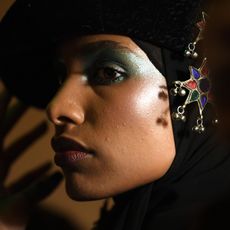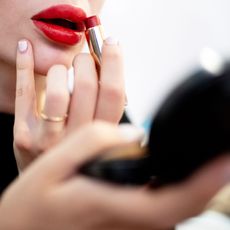
Up until your 30th birthday, you lose about a million skin cells every 40 minutes. Sounds gross, but this desirable sloughing is actually what gives you the dewy skin that radiates youth. "For the first few decades, your epidermis renews itself every 30 days, but by the time you're 40, it takes about 45 days," says Dr. Kathy Fields, assistant clinical professor of dermatology at UCSF. Unfortunately, this shedding slowdown is a reflection of your body's gradual aging process. Long before menopause, the same hormonal production shifts that sap your fertility will start showing their signs on your face. But before you start stockpiling your pantry with soy and estrogen supplements (which may raise your risk of breast cancer because of their systemic effects), try treating your hormonal skin issues safely, from the outside in.
Breakout Role
Just as you may see a little thinning in your hairline or the slight shadow of a moustache, more blackheads and blemishes are a sign of aging. "About a third of women will get adult acne, usually in their early 30s, even if they didn't have breakouts when they were younger," says Beverly Hills dermatologist Dr. Stuart Kaplan. "Starting in your late 20s, estrogen levels decline faster than testosterone." Because testosterone is an androgenic hormone, it increases masculine qualities (hence the new facial hair) and boosts oil production, plugging your pores and causing blemishes. The difference between adult acne and the teenage type? Small red bumps (not painful, cystic pimples) are more common when you're older, according to Kaplan, and acne along the jawline or around the mouth are a telltale sign that you're dealing with a hormonal breakout. Going on the birth-control pill or spironolactone (a diuretic with antiandrogenic effects) will balance hormone levels and reduce breakouts. For a nonprescription approach, try combination acne-and-wrinkle-fighting formulas that gently keep skin clear without over-stripping.
See Spot, Run
Even if you haven't had a baby, brown, patchy melasma (aka the mask of pregnancy) can appear if you take birth-control pills. "Estrogen turns on melanin pigment production, so being on the Pill can be a trigger," explains Fields. "If you're genetically prone to melasma, you'll have brown spots, even if you stop taking the Pill." Since pigment problems are notoriously difficult to treat, Fields recommends strict sun avoidance and a cocktail of antioxidants and sunscreen to keep dark dots at bay.
Dry Spell
Thyroid function naturally peters out over time, which means less hormone production overall. But many women are diagnosed as hypothyroid during or after pregnancy. "When your thyroid function is low, skin becomes dry and scaly," explains Miami dermatologist Dr. Fredric Brandt. He also notes that the epidermis starts losing moisturizing hyaluronic acid when you hit your late 20s. Since estrogen enhances hyaluronic acid production, declining estrogen levels mean less moisture. Kaplan describes the result: "Your skin becomes leathery and starts to crack like an old raincoat. The purpose of skin is to act like a barrier. As your face gets drier, it also gets more sensitive." The good news is that you can replenish hyaluronic acid topically. Sealing in serums with a cream will protect against irritation and further moisture loss.
Stay In The Know
Marie Claire email subscribers get intel on fashion and beauty trends, hot-off-the-press celebrity news, and more. Sign up here.
Timelines
Estrogen is stored in fat, so severe dieters will look older, faster, warns Fields. Aside from hyaluronic acid production, estrogen also affects collagen and elastin levels. And hormonal dips thin the skin, making it less pliable and more prone to wrinkling. "After age 30, you're losing 1 percent of your collagen a year," says Fields. "Peptides, growth factors, and retinols will help rebuild the collagen, but elastin is difficult to replace." Elastin is responsible for—you guessed it—elasticity, so skin becomes looser and less flexible over time. "Facial wrinkles occur when the skin becomes too big for the tissue underneath," explains Kaplan. The first place you'll start seeing fine lines is around the eyes (the periorbital region), where skin is the thinnest. When peptide-fortified eye and face creams are no longer enough, Kaplan recommends lasers and injectable fillers to plump out the padding.
Slacking Off
In the decade leading up to menopause, testosterone finally drops as much as estrogen. You'll see less acne, but the deepest layers of your skin will start to thin and sag. Also, early hormone-related bone loss collapses facial structure, squaring off formerly rounded eye sockets (causing dark circles under the eyes) and increasing skin slackening. Going on and off the Pill makes things worse, warns Fields: "Skin looks more juicy when you're on the Pill, but if you're playing around with it, your face will get dehydrated and drop earlier." However, topical applications of plant-derived estrogens (phytoestrogens like soy, green tea, and wild yam) are safe and can help firm up the face. "If you start applying phytoestrogens in your 40s," says Boston dermatologist Dr. Ranella Hirsch, "I'd bet money that it would help prevent much of the sagging that occurs after menopause."
Once hormone production grinds almost to a halt (hello, menopause!), skin changes dramatically all over your body. "Thirty percent of your collagen is lost in the first five years after menopause. As a result, not only will your face fall, but you'll also see more cellulite—your hormones are gone and your body turns to Jell-O," says Fields. "Forty-year-olds still look good, but even Demi Moore will turn to gush." Stay tuned for Demi's solution (because you know that at age 47, she won't go down without a fight).
-
 All the Easter Eggs and Name Drops on Taylor Swift's 'The Tortured Poets Department,' Explained
All the Easter Eggs and Name Drops on Taylor Swift's 'The Tortured Poets Department,' ExplainedDigging through the fan theories so you don't have to.
By Quinci LeGardye Published
-
 This Week's Best On-Sale Picks Include a Tory Burch Bag and Pretty Silver Ballet Flats
This Week's Best On-Sale Picks Include a Tory Burch Bag and Pretty Silver Ballet FlatsWarm weather is finally here—it's time to dress like it.
By Brooke Knappenberger Published
-
 A Sporty It-Sneaker Era Is About to Begin
A Sporty It-Sneaker Era Is About to BeginNike's next Air models are designed for Olympic athletes, but they'll soon be all over street style.
By Halie LeSavage Published
-
 The Best Cold Plunge Tubs for At-Home Ice Baths
The Best Cold Plunge Tubs for At-Home Ice BathsIs soaking in 50 degree water actually good for you?
By Samantha Holender Published
-
 A Dermatologist's Guide to Accutane
A Dermatologist's Guide to AccutaneWhat to know about Isotretinoin, a.k.a. Accutane, if you’re struggling with severe acne.
By Samantha Holender Published
-
 The 44 Best Skincare Products Changing the Game
The 44 Best Skincare Products Changing the GameFind your formula.
By Maya Allen Published
-
 The Correct Way to Wash Your Face, According to Experts
The Correct Way to Wash Your Face, According to ExpertsThe eight commandments of cleansing.
By Gina Way Published
-
 The Signs Your Makeup Has Expired
The Signs Your Makeup Has ExpiredLike food, expired makeup can become a breeding ground for bacteria.
By Hana Hong Published
-
 Moringa Oil Is Here to Save Your Skin, Your Hair, and the Planet
Moringa Oil Is Here to Save Your Skin, Your Hair, and the PlanetMoringa is so much more than the source of a trendy beautifying oil. For the people of northern Uganda, this sustainable resource represents the future.
By Jennifer Huxta Published
-
 What a Beauty Editor Does 2 Weeks Before Vacation
What a Beauty Editor Does 2 Weeks Before VacationA Marie Claire beauty editor put Olay Moisture Ribbons Plus Shea + Peony Blossom Body Wash to the test just two weeks before summer vacation. Read an honest review, here.
By Maya Allen Published
-
The FDA Just Approved a Non-Surgical, Completely Painless, 20-Minute Face Lift
No, this isn’t a joke—it’s a very big deal.
By Chloe Metzger Published